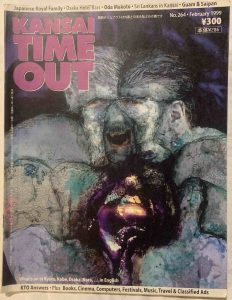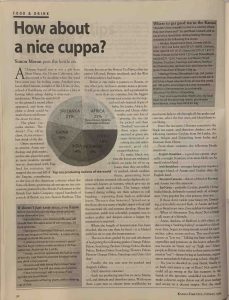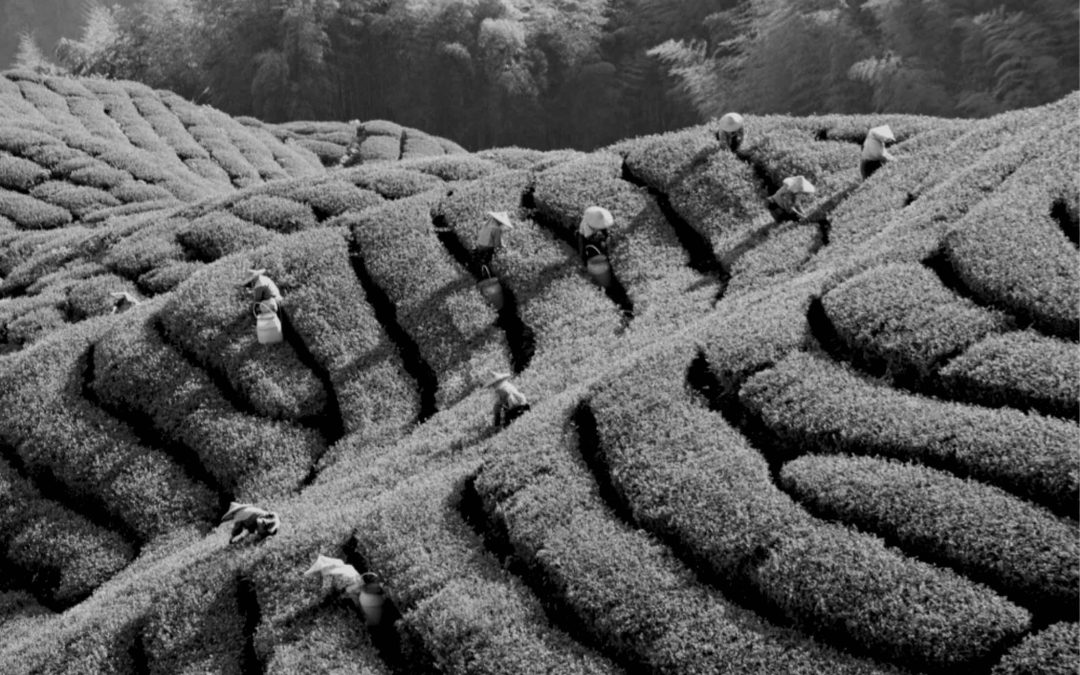Bilingual Edition
おいしい紅茶はいかが?カッパ:バイリンガル版
Originally published in Kansai Time Out, February 1999. Shortened for 2025. Contact information, prices and statistics may be out of date.
This bilingual edition contains the full English article first. Please scroll down for the Japanese translation.
1999年2月「関西タイムアウト」に初出。2025年版として短縮・編集。連絡先、価格、統計情報などは現在と異なる場合があります。
本バイリンガル版は、英語記事全文を最初に掲載しています。日本語訳は後半に掲載していますので、スクロールしてご覧ください。
A Chinese legend attributes the discovery of tea to Shen Nung, the Divine Cultivator, who noticed some leaves had blown into his boiling water. Another version tells of Daruma, the founder of the Ch’an (Zen) school of Buddhism, who cut off his eyelids in frustration after falling asleep during a nine-year meditation. Where they landed, a plant grew—one that produced a drink said to reduce drowsiness.
The plant is Camellia sinensis. The drink is known variously as t’u, ch’a, chaw, t’e, tee—or simply, tea.
Referenced in ancient Asian philosophy and mythology, tea has also featured prominently in Western history. In Britain, it came to symbolise The Empire itself and even contributed to its decline: the Boston Tea Party, led by the Sons of Liberty, protested tax concessions granted to the British East India Company by dumping tea into Boston Harbour. Britain retaliated, and the American War of Independence followed.


Before tea reaches Boston or any other port, it undergoes several processes. Though tea can grow in many climates and is cultivated in over 25 countries, the largest producers include India, Sri Lanka, Indonesia, China and various parts of Africa. After meticulous cultivation and pruning, tea is harvested and processed into one of three types: unfermented (green tea), semi-fermented (oolong), and fully fermented (black tea).
Black tea production begins by withering the leaves on racks for 18–24 hours. They are then rolled to trigger oxidation, which generates heat and releases essential oils and polyphenols (commonly mislabelled as tannins), responsible for tea’s flavour, aroma, and colour. After rolling, clumps are separated during roll breaking, and the leaves are fermented. Spread on the floor, they oxidise and develop a copper colour. Short fermentation yields lighter, more pungent teas; longer fermentation deepens colour and reduces acidity.
When fermentation is complete, the tea is fired—dried with hot air to halt the process.
The leaves are then graded by size and completeness: Orange Pekoe, Pekoe, Souchong, Broken Orange Pekoe, Broken Pekoe, Broken Pekoe Souchong, Flowery Pekoe, Flowery Orange Pekoe, Fannings and Dust.
Next, the tea is packed and shipped.
Each growing region offers a unique combination of soil, altitude, and climate, producing distinct flavours. With over 1,500 varieties worldwide, blending becomes essential.
This is the role of the tea taster. Among the most important for black tea are the following:
- Ceylon (Sri Lanka)
- Assam, Nilgiri, and Darjeeling (India)
- Keemun (China)
Notable blends include:
- English Breakfast: Once pure Keemun, now usually Assam and Ceylon.
- Irish Breakfast: A stronger Assam/Ceylon blend.
- Russian/Caravan: A Keemun and Assam mix, often used in a samovar.
- Earl Grey: Ceylon, or occasionally China/India blends, flavoured with bergamot oil.
Single origin options such as second flush Darjeeling or unblended Assam are also widely enjoyed. Alternatively, one can blend their own.
Afternoon Tea refers not to a blend but a tradition. Anne, Duchess of Bedford (1788–1861), began taking tea with snacks in the late afternoon to relieve hunger pangs. This became known as ‘low tea’. In contrast, the working classes took their tea with a full meal—meat and potatoes—in the evening, a practice known as ‘high tea’ or simply ‘tea’. In many British households, ‘tea’ still refers to the evening meal, with ‘dinner’ at midday and ‘supper’ before bed.
Even after selecting a blend, poor preparation can spoil the result. Discard teabags and invest in a proper teapot. Ideally, a round one with a practical handle.
Poor preparation can spoil the results
Use freshly drawn water, more than the teapot’s capacity. Bring to a vigorous boil. Swirl a little boiling water in the teapot to warm it, then discard. Add loose tea—one teaspoon per person plus one for the pot. Fill the pot with freshly boiling water, following the adage: “Unless the water boiling be, vain the attempt to make the tea.” Stir and allow to brew for 3–5 minutes. Use a tea cosy in colder weather. Pour through a strainer, adding milk, lemon or sugar to taste. If no strainer is available, sip carefully. Biscuits may be dunked with discretion, removing them just before structural failure.
Avoid: instant tea (favoured by students), decaffeinated or tannin-free teas (equivalent to alcohol-free beer), and herbal or fruit infusions—these are not tea.
As Noel Coward observed, “Wouldn’t it be dreadful to live in a country where they don’t have tea?”
Fine teas are available at:
- Hankyu Department Store: Umeda (06-361-1381), Kobe (078-371-8600)
- Daimaru: Kobe (078-331-8121), Kyoto (075-211-8111), Osaka Umeda (06-343-1231), Shinsaibashi (06-271-1231)
- Fortnum & Mason, Royal Doulton, Fauchon, Twinings, and others
Both Hankyu and Daimaru offer loose tea by the gram. Prices start around ¥700 per 100g.
Mariage Frères, located at the third corner south of Shinsaibashi Station exit 6 (tel: 06-213-6575), offers an extensive global selection. Prices range from ¥600 for Vietnamese teas to ¥16,400 for premium Darjeeling.
Local supermarkets may also carry reputable brands, including Brooke Bond, often at lower prices (from ¥418 for 90g).
Additional Uses for Tea
- Eye care: Wet teabags soothe tired or infected eyes.
- Digestive issues: A strong cup may relieve sore gums, diarrhoea, or cramps.
- Skin: Rubbing wet teabags on the skin can offer a UV-free tan.
- Feet: A hot tea footbath can refresh tired feet.
- Hair: Tea may help darken greying hair.
- Carpets: Sprinkling tea leaves can deter fleas.
- Plants: Add tea to revive wilting houseplants.
Tea Leaf Reading
In ancient China, bells were used to ward off evil; later, their interiors were read for omens. The teacup, similarly shaped, took on a similar role. This spread globally and was particularly common in the Scottish Highlands, where a ‘spae-wife’ read fortunes from tea leaves.
A guest would leave a small amount of tea, swirl the cup three times anticlockwise with the left hand, then invert it onto the saucer. Patterns were interpreted from the handle (representing the drinker) outward, with proximity to the rim indicating the near future and the base representing distant events.
Common symbols and their meanings:
- Good luck: triangle, star, clover, leaf, anchor, tree, garland, flower, bridge, crown
- Bad luck: coffin, cross, serpent, rat, hourglass, steeple, sword, gun, raven, owl, monkey
- Other: heart (love), cat (treachery), cow (prosperity), dog (loyalty), book (revelation), cloud (doubt), ladder (progress), ring (marriage), egg (increase)
Export Data (Tea Council)
Top global tea exporters:
- Africa (Kenya, Malawi, Tanzania, Zimbabwe): 25%
- Sri Lanka: 21%
- China: 18%
- India: 14%
- Indonesia: 8%
- Others: remaining percentage
The top 10 producers, with their production volumes and calculated percentages, are as follows:
| Rank | Country | Production (tonnes) | % of Global Production | |
| 1 | China | 2,400,000 | 40% | 中国 |
| 2 | India | 900,000 | 15% | インド |
| 3 | Kenya | 305,000 | 5.08% | ケニア |
| 4 | Sri Lanka | 300,000 | 5% | スリランカ |
| 5 | Turkey | 175,000 | 2.92% | トルコ |
| 6 | Indonesia | 157,000 | 2.62% | インドネシア |
| 7 | Vietnam | 117,000 | 1.95% | ベトナム |
| 8 | Japan | 89,000 | 1.48% | 日本 |
| 9 | Iran | 84,000 | 1.4% | イラン |
| 10 | Argentina | 70,000 | 1.17% | アルゼンチン |
The top 5 exporters:
| Rank | Country | Export Value (USD) | % of Global Exports (2023) | Japanese Name |
| 1 | China | $1,739,000,000 | 23.8% | 中国 |
| 2 | Kenya | $1,354,218,000 | 18.5% | ケニア |
| 3 | Sri Lanka | $1,289,913,000 | 17.6% | スリランカ |
| 4 | India | $706,327,000 | 9.6% | インド |
| 5 | Poland | $235,033,000 | 3.2% | ポーランド |
カッパ
中国の伝説によれば、お茶は神農という神が発見したとされます。ある日、風で吹き飛ばされた葉が彼の沸騰した湯に入り、その香りと味に気づいたというのです。
別の説では、禅宗(チャン)の開祖・達磨が、九年間の瞑想中に居眠りしてしまった怒りから、自らのまぶたを切り落としました。そのまぶたが落ちた場所に植物が生え、それが眠気を和らげる飲み物の元になったと伝えられています。
その植物こそがカメリア・シネンシス(チャノキ)であり、その飲み物は、t’u、ch’a、chaw、t’e、tee——つまり「お茶」です。
お茶はアジアの古代哲学や神話によく登場しますが、西洋史においても重要な役割を果たしてきました。イギリスでは、お茶は長らく帝国の象徴とされ、やがてその衰退にも関わることになります。
「ボストン茶会事件」では、自由の息子たちが、英国東インド会社に与えられた税制優遇措置に抗議して、ボストン港に茶を投げ捨てました。イギリスは報復し、アメリカ独立戦争が勃発しました。
しかし、お茶が港に届くまでには、実に多くの工程を経る必要があります。
お茶はさまざまな気候で育ち、現在では25カ国以上で栽培されています。最大の生産国は、インド、スリランカ、インドネシア、中国、そしてアフリカ諸国です。
丁寧な栽培と剪定を経て収穫された茶葉は、次の3種類のいずれかに加工されます:
・未発酵(緑茶)
・半発酵(烏龍茶)
・完全発酵(紅茶)
紅茶の製造は、まず葉を18~24時間かけて萎れさせる「萎凋」から始まります。次に「揉捻(じゅうねん)」によって酸化を促進し、熱が発生します。これにより、精油やポリフェノール(俗に「タンニン」と呼ばれる)が抽出され、風味・香り・色が生まれます。
次に「ロールブレイク」で茶葉の塊をほぐし、床に広げて発酵させます。
酸化によって茶葉は銅色に変化し、成分が成熟していきます。短時間の発酵では淡く刺激的な風味に、長時間では色が濃くなり酸味が和らぎます。
その後、高温の熱風で茶葉を乾燥させ、発酵を止めます。これを「乾燥処理」と言います。
乾燥が終わった茶葉は、サイズや形によって等級が分けられます:
オレンジペコー、ペコー、スーチョン、ブロークンオレンジペコー、ブロークンペコー、ブロークンペコースーチョン、フラワリーペコー、フラワリーオレンジペコー、ファニングス、ダストなど。
その後、包装・出荷されます。
各地の土壌、高度、気候の組み合わせにより、お茶の風味は大きく異なります。
世界には1500種類以上ものお茶が存在し、ブレンドの技術が必要とされます。
ここで登場するのがティーテイスターです。
特に紅茶で重要とされる品種は以下の通り:
・セイロン(スリランカ)
・アッサム、ニルギリ、ダージリン(インド)
・キームン(中国)
代表的なブレンドには以下があります:
・イングリッシュ・ブレックファスト:元はキームン100%、現在はアッサムとセイロンが主流
・アイリッシュ・ブレックファスト:アッサムとセイロンのより濃厚なブレンド
・ロシアン/キャラバン:キームンとアッサムのブレンド。サモワールで使用されることも
・アールグレイ:セイロンを主体に、ベルガモットオイルで香りづけ
また、セカンドフラッシュのダージリンや単一産地のアッサムなど、ブレンドされていない紅茶も人気です。自分でブレンドを楽しむのも良いでしょう。
「アフタヌーンティー」はブレンドではなく、伝統です。
ベッドフォード公爵夫人アン(1788–1861)は、午後の空腹感を紛らわすために、軽食とともにお茶をとる習慣を始めました。これが「ロー・ティー」として知られるようになりました。
一方、労働者階級は夕食として、肉やジャガイモを含む食事とともにお茶を楽しみました。これが「ハイ・ティー」または単に「ティー」と呼ばれます。
現在でも多くのイギリス家庭では、「ティー=夕食」を意味します。
一杯の油断が、すべてを台無しにする。
どんなに良い茶葉を選んでも、淹れ方が悪ければ台無しです。
ティーバッグは捨て、適したティーポットを用意しましょう。丸くて取っ手のしっかりしたものがおすすめです。
新鮮な水をポットの容量より多めに沸かし、激しく沸騰させます。
まず、ポットを温めるために少量の湯を注いで回し、捨てます。
1人につきティースプーン1杯分、さらに「ポットの分」1杯を加え、沸騰した湯を注ぎます。
「水が沸騰していなければ、茶を淹れる価値なし」という格言通りに。
3~5分蒸らし、寒い日はティーコージーを使います。
茶こしで注ぎ、お好みでミルク・レモン・砂糖を。
茶こしがない場合は注意深く飲みましょう。
ビスケットの浸し過ぎにはご注意を。崩れる前に救出を。
以下のものは避けましょう:
・インスタントティー(学生向き)
・カフェイン・タンニン除去茶(ノンアルコールビール並み)
・ハーブティーやフルーツティー(お茶ではありません)
ノエル・カワードもこう言いました——
「お茶のない国で暮らすなんて、ぞっとするじゃないか。」
高品質な紅茶は以下の店舗で手に入ります:
- 阪急百貨店:梅田(06-361-1381)、神戸(078-371-8600)
- 大丸:神戸(078-331-8121)、京都(075-211-8111)、大阪梅田(06-343-1231)、心斎橋(06-271-1231)
- フォートナム・アンド・メイソン、ロイヤル・ドルトン、フォション、トワイニングなども取り扱いあり
阪急と大丸では、茶葉を100g単位で量り売りしています。価格はおよそ100gあたり700円から。
心斎橋駅6番出口から南に3つ目の角にある**マリアージュ・フレール(06-213-6575)**では、世界中の紅茶を扱っています。価格帯は、ベトナム産が100gで600円から、高級ダージリンは16,400円まで幅広く揃っています。
また、地元のスーパーにも見逃せない商品があります。私の近所のダイエーには、上記ブランドのほか、ブルック・ボンドのブレンドティーが90gで418円というお得な価格で並んでいます。
お茶の意外な活用法
- 目のケア:濡らしたティーバッグをまぶたに当てると、疲れ目や感染症の緩和に。
- 消化器系の不調:歯茎の痛み、下痢、腹痛には、スプーンが立つほど濃い紅茶を。
- 日焼け代わり:湿ったティーバッグを肌にこすれば、紫外線不要でほんのり日焼け風の色に。
- 足の疲れに:熱い紅茶で足湯をしながら、一杯飲んでリラックス。
- 髪染めに:紅茶で白髪を目立たなく。
- ノミ対策:カーペットに茶葉を撒くと、ノミが寄りつかなくなる。
- 植物の活力アップ:しおれた観葉植物に紅茶を注ぐと元気を取り戻します。
茶葉占い
古代中国では、悪霊を追い払うために鐘を鳴らし、その内側を見て吉兆を占いました。ティーカップの形が鐘に似ていることから、残った茶葉の形で運勢を占うようになり、この文化は世界中に広まりました。
スコットランド高地では「スパイワイフ(予言者の老婆)」がカップを読み解いていました。
やり方はこうです:
飲み終わったカップに少量の茶を残し、左手で3回反時計回りに回します。そしてソーサーの上に伏せて、茶が流れきるのを待ちます。
ハンドルが「あなた自身」を表し、そこから左回りに読み進めます。カップの縁に近いほど近未来、底に近いほど遠い未来を意味します。
よくあるシンボルとその意味:
- 幸運を示すもの:三角形、星、クローバー、葉、錨、木、花輪、花、橋、王冠
- 不運を示すもの:棺、十字架、蛇、ネズミ、砂時計、教会の尖塔、剣、銃、カラス、フクロウ、猿
- その他のシンボル:
- ハート:愛
- 猫:裏切り
- 牛:繁栄
- 犬:忠誠
- 本:啓示
- 雲:疑念
- はしご:昇進
- 指輪:結婚
- 卵:増加
生産量と割合に基づく上位10か国の生産国は以下の通りです。
| Rank | Country | Production (tonnes) | % of Global Production | |
| 1 | China | 2,400,000 | 40% | 中国 |
| 2 | India | 900,000 | 15% | インド |
| 3 | Kenya | 305,000 | 5.08% | ケニア |
| 4 | Sri Lanka | 300,000 | 5% | スリランカ |
| 5 | Turkey | 175,000 | 2.92% | トルコ |
| 6 | Indonesia | 157,000 | 2.62% | インドネシア |
| 7 | Vietnam | 117,000 | 1.95% | ベトナム |
| 8 | Japan | 89,000 | 1.48% | 日本 |
| 9 | Iran | 84,000 | 1.4% | イラン |
| 10 | Argentina | 70,000 | 1.17% | アルゼンチン |
輸出量上位5か国:
| Rank | Country | Export Value (USD) | % of Global Exports (2023) | Japanese Name |
| 1 | China | $1,739,000,000 | 23.8% | 中国 |
| 2 | Kenya | $1,354,218,000 | 18.5% | ケニア |
| 3 | Sri Lanka | $1,289,913,000 | 17.6% | スリランカ |
| 4 | India | $706,327,000 | 9.6% | インド |
| 5 | Poland | $235,033,000 | 3.2% | ポーランド |

